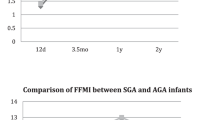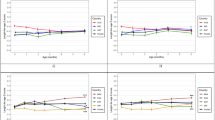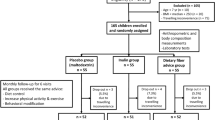Abstract
Background
The impact of intrauterine and extrauterine growth on later insulin resistance and fat mass (FM) in very low birth weight (VLBW) infants is not well established. The aim of our study was to evaluate the effects of intrauterine and early/late extrauterine growth on later insulin resistance and body composition in VLBW infants from 6 months’ corrected age (CA) to 36 months.
Methods
Prospective measurements of body composition by dual-energy X-ray absorptiometry and insulin resistance by homeostasis model assessment insulin resistance (HOMA-IR) along with other fasting plasma biochemistries were made in 95 VLBW infants at 6, 12, 18, and 24 months’ CA and 36 months’ postnatal age. Mixed-effect models were used to evaluate the effects of age, sex, maturation status, and Δweight SD score on percentage FM (PFM), FM index (FMI), fat-free mass index (FFMI), and HOMA-IR.
Results
PFM and FMI were negatively associated with a decrease in weight–SD scores from birth to 36 weeks’ postmenstrual age (PMA; P=0.001) and from 36 weeks’ PMA to 6 months’ CA (P=0.003). PFM and FMI were higher in AGA than in small for gestational age (SGA) infants. HOMA-IR was not associated with the Δweight–SD scores in either period.
Conclusions
Catch-down growth in terms of weight is associated with persistently lower adiposity but not insulin resistance up to 36 months of age.
Similar content being viewed by others
Log in or create a free account to read this content
Gain free access to this article, as well as selected content from this journal and more on nature.com
or
References
Hofman PL, Regan F, Jackson WE et al, Premature birth and later insulin resistance. N Engl J Med 2004;351:2179–86.
Tinnion R, Gillone J, Cheetham T, Embleton N . Preterm birth and subsequent insulin sensitivity: a systematic review. Arch Dis Child 2014;99:362–8.
Singhal A, Fewtrell M, Cole TJ, Lucas A . Low nutrient intake and early growth for later insulin resistance in adolecents born preterm. Lancet 2003;361:1089–97.
Bazaes RA, Alegría A, Pittaluga E, Avila A, Iñiguez G, Mericq V . Determinants of insulin sensitivity and secretion in very-low-birth-weight children. J Clin Endocrinol Metab 2004;89:1267–72.
Finken MJ, Kejizer-Veen MG, Dekker FW et al, Preterm birth and later insulin resitance: effects of birth weight and postnatal growth in a population based longitudinal study from birth into adult life. Diabetologia 2006;49:478–85.
Fewtrell MS, Doherty C, Cole TJ, Stafford M, Hales CN, Lucas A . Effects of size at birth, gestational age and early growth in preterm infants on glucose and insulin concentrations at 9-12 years. Diabetologia 2000;43:714–7.
Irving RJ, Belton NR, Elton RA, Walker BR . Adult cardiovascular risk factors in premature babies. Lancet 2000;355:2135–6.
Yanni D, Darendeliler F, Bas F, Aydin BK, Coban A, Ince Z . The role of leptin, soluble leptin receptor, adiponectin and visfatin in insulin sensitivity in preterm born children in prepubertal stages. Cytokine 2013;64:448–53.
Johnson MJ, Wootton SA, Leaf AA, Jackson AA . Preterm birth and body composition at term equivalent age: a systematic review and meta-analysis. Pediatrics 2012;130:e640–9.
Sepúlveda C, Urquidi C, Pittaluga E et al, Differences in body composition and resting energy expenditure in childhood in preterm children born with very low birth weight. Horm Res Paediatr 2013;79:347–55.
Breukhoven PE, Kerkhof GF, Willemsen RH, Hokken-Koelega AC . Fat mass and lipid profile in young adults born preterm. J Clin Endocrinol Metab 2012;97:1294–302.
Euser AM, Finken MJ, Kejizer-Veen MG, Hille ET, Wit JM, Dekker FW . Dutch POPS-19 Collaborative Study Group. Associations between prenatal and infancy weight gain and BMI, fat mass, and fat distribution in young adulthood: a prospective cohort study in males and females born very preterm. Am J Clin Nutr 2005;81:480–7.
Fewtrell MS, Lucas A, Cole TJ, Wells JC . Prematurity and reduced body fatness at 8-12 y of age. Am J Clin Nutr 2004;80:436–40.
Kerkhof GF, Willemsen RH, Leunissen RW, Breukhoven PE, Hokken-Koelega AC . Health profile of young adults born preterm: negative effects of rapid weight gain in early life. J Clin Endocrinol Metab 2012;97:4498–506.
Gray IP, Cooper PA, Cory BJ, Toman M, Crowther NJ . The intrauterine environment is a strong determinant of glucose tolerance during the neonatal period, even in prematurity. J Clin Endocrinol Metab 2002;87:4252–6.
Leipälä JA, Raivio KO, Sarnesto A, Panteleon A, Fellman V . Intrauterine growthrestriction and postnatal steroid treatment effects on insulin sensitivity in preterm neonates. J Pediatr 2002;141:472–6.
Rotteveel J, van Weissenbruch MM, Twisk JWR, Delemarre-Van de Waal HA . Infant and childhood growth patterns, insulin sensitivity, and blood pressure in prematurely born young adults. Pediatrics 2008;122:313–21.
Martos-Moreno GA, Barrios V, Sáenz de Pipaón M et al, Influence of prematurity and growth restriction on the adipokine profile, IGF1, and ghrelin levels in cord blood: relationship with glucose metabolism. Eur J Endocrinol 2009;161:381–9.
Sáenz de Pipaón M, Martínez-Biarge M, Dorronsoro I et al, Growth in preterm infants until 36 weeks postmenstrual age is close to target recommendations. Neonatology 2014;106:30–6.
Fenton R Tanis, Kim H Jae . A systematic review and meta-analysis to revise the Fenton growth chart for preterm infants. BMC Pediatr 2013;13:59.
Rawlings DJ, Cooke RJ, McCormick K et al, Body composition of preterm infants during infancy. Arch Dis Child Fetal Neonatal Ed 1999;80:F188–91.
Ong KK, Ahmed ML, Emmett PM, Preece MA, Dunger DB . Association between postnatal catch-up growth and obesity in childhood: prospective cohort study. Br Med J 2000;320:967–71.
Butte NF, Hopkinson JM, Wong WW, Smith EO, Ellis KJ . Body composition during the first 2 years of life: an updated reference. Pediatr Res 2000;47:578–85.
Griffin IJ, Cooke RJ . Development of whole body adiposity in preterm infants. Early Hum Dev 2012;88 (Suppl 1): S19–24.
Ramel SE, Gray HL, Ode KL, Younge N, Georgieff MK, Demerath EW . Body composition changes in preterm infants following hospital discharge: comparison with term infants. J Pediatr Gastroenterol Nutr 2011;53:333–8.
Lapillonne A, Griffin IJ . Feeding preterm infants today for later metabolic and cardiovascular outcomes. J Pediatr 2013;162:S7–16.
Regan FM, Cutfield WS, Jefferies C, Robinson E, Hofman PL . The impact of early nutrition in premature infants on later childhood insulin sensitivity and growth. Pediatrics 2006;118:1943–9.
Slining MM, Kuzawa CW, Mayer-Davis EJ, Adair LS . Evaluating the indirect effect of infant weight velocity on insulin resistance in young adulthood: a birth cohort study from the Philippines. Am J Epidemiol 2011;173:640–8.
Leunissen RW, Kerkhof GF, Stijnen T, Hokken-Koelega A . Timing and tempo of first-year rapid growth in relation to cardiovascular and metabolic risk profile in early adulthood. JAMA 2009;301:2234–42.
Author information
Authors and Affiliations
Corresponding author
Ethics declarations
Competing interests
The authors declare no conflict of interest.
Additional information
Statement of Financial Support
This study was partially funded by the Fondo de Investigación Sanitaria and Fondos FEDER (Grants: PI041631 to M.S.P. and PI100747 and PI1302195 to J.A.).
Rights and permissions
About this article
Cite this article
Saenz de Pipaon, M., Dorronsoro, I., Álvarez-Cuervo, L. et al. The impact of intrauterine and extrauterine weight gain in premature infants on later body composition. Pediatr Res 82, 658–664 (2017). https://doi.org/10.1038/pr.2017.123
Received:
Accepted:
Published:
Issue date:
DOI: https://doi.org/10.1038/pr.2017.123
This article is cited by
-
Infant Growth and Long-term Cardiometabolic Health: a Review of Recent Findings
Current Nutrition Reports (2019)
-
Developmental Programming of Body Composition: Update on Evidence and Mechanisms
Current Diabetes Reports (2019)



